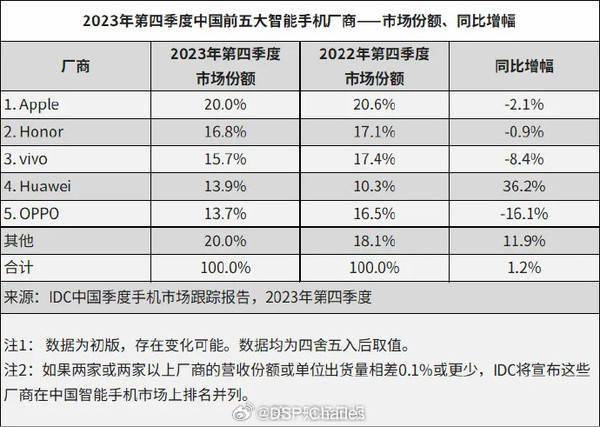Huawei regains top five position in China market in Q4 2023, while Xiaomi drops out
In the fourth quarter of 2023, according to the IDC report, Huawei regained its position in the top five in the Chinese market (13.9%), while Xiaomi dropped out. First Financial believes that Xiaomi’s drop from the top five in the Chinese market may be due to its focus on high-end products.

Lei Jun
2021 was the peak of Xiaomi’s market share in the smartphone market. Xiaomi’s share of the Chinese smartphone market rose from 8.9% in 2016 to 15.8%. However, starting from the first quarter of 2022, Xiaomi’s shipments and market share began to decline. At the same time, Xiaomi’s mobile phone business revenue decreased from around 50 billion yuan per quarter in 2021 to 40 billion yuan per quarter in 2022.

First Financial indicated that what propelled Xiaomi to its peak was Huawei’s temporary absence. Due to US sanctions, Huawei’s P50 series phones in 2021 only used 4G chips. Moreover, Huawei was even absent from the high-end market as it did not release any phones that year from its Mate series. Various phone manufacturers, including vivo, OPPO, and Apple, sought to vie for the high-end market share left by Huawei. Xiaomi was relatively successful in this, achieving an 11% growth compared to the fourth quarter of 2020.
In 2019, as Huawei began to face sanctions, Xiaomi proposed a strategy of focusing on high-end products, aiming to emulate Apple’s high-end brand. Xiaomi launched three offline retail models: Xiaomi flagship stores, Xiaomi exclusive stores, and authorized Xiaomi stores.

In 2020, Xiaomi introduced its first high-end product, the Xiaomi 10 series. In 2021, it densely released two more series, the high-end positioned Xiaomi 11 and Xiaomi 12. Alongside the sales of these high-end models, Xiaomi significantly expanded its offline stores from 2020 to 2021.
However, Xiaomi’s high-end path was soon met with challenges. Firstly, the era in which Xiaomi sought high-end development was different from Huawei’s rise. Global demand for phone upgrades significantly declined after 2021, as the pandemic led many to prioritize saving money. Additionally, the Xiaomi 10, 11, and 12 series did not create enough incentive for users to upgrade in terms of functionality. In fact, even Apple’s iPhones introduced in the past two years did not offer significant updates. On the other hand, Honor, after its separation, rapidly rose to prominence, inheriting most of the market space left by Huawei.
Despite Xiaomi’s optimism, which led to the rapid expansion of numerous offline stores and overproduction of phones, the company faced setbacks. Wind data shows that Xiaomi’s inventory surpassed 50 billion yuan for the first time at the end of 2021, reaching a new high of 57.8 billion yuan by the end of June 2022, accounting for 19.72% of total assets, the highest level since its listing, with the digestion of this inventory continuing into 2023.